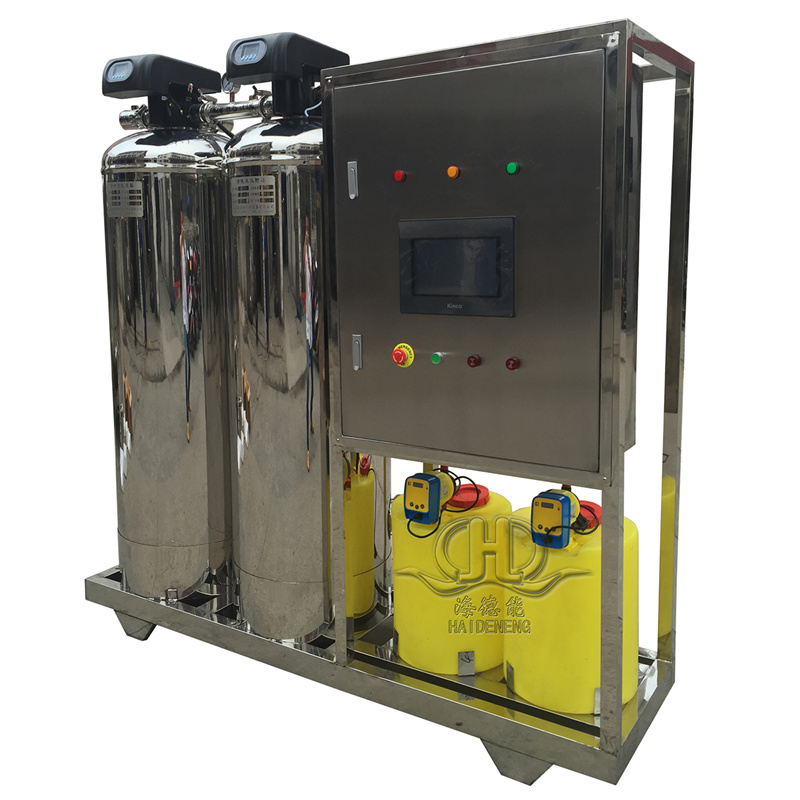Salt Reduction Filtration Fully Automatic Reverse Osmosis Sand Filtration Carbon Filtration Water Treatment System
Product description
1. Salt Reduction via Reverse Osmosis (RO)
Role:
- Salt and Dissolved Solids Removal: RO membranes reject up to 95–99% of ions (e.g., sodium, chloride), heavy metals, and total dissolved solids (TDS), reducing salt content to meet potable or industrial standards.
- High-Purity Output: Produces water with resistivity >1 MΩ·cm (deionized standard) or TDS <50 ppm.
Mechanism:
- High-pressure pumps force feedwater through semi-permeable RO membranes, allowing water molecules to pass while retaining salts and contaminants.
Applications:
- Seawater Desalination: Converts seawater into freshwater for municipal or industrial use.
- Brackish Water Treatment: Reduces TDS in groundwater or agricultural runoff.
- Food & Beverage: Ensures low-sodium water for product formulation.
Benefits:
- Effective Salt Removal: Ideal for regions with saline water sources.
- Versatility: Compatible with varying salinity levels.
Challenges:
- Produces a concentrated brine reject stream requiring proper disposal.
- Sensitive to scaling (e.g., calcium carbonate) and fouling (e.g., organic matter).
2. Sand Filtration
Role:
- Pre-Treatment for RO: Removes suspended solids, silt, turbidity, and particulates (5–100 µm) that could foul RO membranes.
- Protection: Extends RO membrane lifespan by preventing clogging.
Mechanism:
- Uses layered sand and gravel beds to trap particles via mechanical straining and sedimentation.
Applications:
- Municipal Systems: Prepares seawater or brackish water for RO desalination.
- Industrial Pre-Treatment: Protects RO membranes in power plants or electronics manufacturing.
Benefits:
- Cost-Effective: Low energy and maintenance costs.
- Low Maintenance: Simple backwashing restores performance.
Challenges:
- Limited removal of dissolved salts, organics, or microorganisms.
3. Carbon Filtration
Role:
- Chemical Contaminant Removal: Adsorbs chlorine, chloramines, pesticides, and organic compounds that degrade RO membranes or affect water quality.
- Taste and Odor Improvement: Eliminates unpleasant smells and flavors caused by organics.
Mechanism:
- Activated carbon (coal, coconut shells) traps contaminants via adsorption. Catalytic carbon enhances chloramine removal.
Applications:
- Drinking Water Systems: Enhances safety and palatability.
- Pharmaceuticals: Removes organic impurities before RO polishing.
Benefits:
- Membrane Protection: Prevents oxidative damage to RO membranes.
- Improved Aesthetics: Ensures water is safe and pleasant for consumption.
Challenges:
- Limited capacity for heavy metals or dissolved inorganics.
- Requires periodic replacement when saturated.
4. Fully Automatic Control System
Role:
- Automation: Manages backwashing, pump pressure, chemical dosing, and alarms via PLC/SCADA interfaces.
- Optimization: Adjusts parameters (e.g., flow rate, pressure) based on real-time sensors (turbidity, TDS, pH).
Mechanism:
- Sensors monitor feedwater quality and system performance, triggering automated maintenance cycles.
Applications:
- Municipalities: Reduces labor costs for large-scale desalination plants.
- Industrial Plants: Ensures consistent output despite feedwater variability.
Benefits:
- Efficiency: Optimizes energy use (e.g., variable-speed pumps) and minimizes downtime.
- Precision: Maintains compliance with regulatory standards.
Challenges:
- High upfront cost for automation infrastructure.
- Requires skilled technicians for troubleshooting.
System Integration and Workflow
- Sand Filtration: Removes suspended solids and turbidity.
- Carbon Filtration: Adsorbs chlorine, organics, and improves water quality.
- RO System: Reduces salt and dissolved solids to ultrapure standards.
- Automation: Coordinates all stages for seamless operation.
Key Applications:
- Municipal Desalination: Converts seawater to drinking water.
- Agriculture: Provides low-salt irrigation water.
- Industrial: CIP (clean-in-place) water for food/beverage processing.
Benefits of the Integrated System
- Comprehensive Treatment: Addresses physical, chemical, and saline contaminants.
- Cost Savings:
- Reduces RO membrane fouling, extending lifespan.
- Energy-efficient automation lowers operational expenses.
- Sustainability: Minimizes brine waste (with concentrate reuse systems) and chemical use.
- Reliability: Automation ensures consistent performance in fluctuating feedwater conditions.
Challenges and Considerations
- Brine Management: Requires proper disposal or evaporation ponds, especially in arid regions.
- Pre-Treatment Needs: Additional steps (e.g., microfiltration) may be needed for highly turbid water.
- Maintenance: Regular filter replacements and membrane cleaning are essential.
Conclusion
This fully automated system is a robust solution for salt reduction and water purification. By integrating sand and carbon filtration with RO technology, it ensures safe, low-sodium water for diverse applications while optimizing energy use and minimizing waste. Automation enhances reliability and efficiency, making it ideal for municipalities, industries, and regions facing saline water challenges. Despite challenges like brine disposal, its benefits in scalability, sustainability, and compliance make it indispensable for modern water treatment needs.












